Ectoparasites are a common cause of pruritus in dogs and cats. Despite there being many ectoparasiticides available to treat these conditions they remain a problem in general practice. In this article we will discuss the clinical signs commonly seen with ectoparasites in dogs and cats, alongside how to diagnose and treat these cases.
Fleas
Flea biology
The main type of flea causing skin disease in dogs and cats is the cat flea (Ctenocephalides felis). Adult cat fleas are obligate parasites and can only survive for short periods off the host once they have fed. It is the adult flea feeding on the host that causes the clinical signs noted in flea allergy. It is presumed that allergens are present in the injected saliva of the flea and it is this that causes the clinical signs. It should alo be remembered that some animals can have an infestation of fleas without having flea allergy.
There are four main stages to the flea life cycle: egg, larva, pupa and adult flea (Figure 1). The adult flea is stimulated to erupt from its pupa when there is vibration, warmth or carbon dioxide from a nearby mammal. The flea then settles on a mammalian host and feeds. Flea larvae feed on adult flea faecal pellets and will often burrow deep into carpets as they do not like heat or light because they are susceptible to drying out. This is important to stress when advising owners to spray the environment to ensure they spray under furniture and around pet bedding areas. Flea eggs and flea faecal pellets are often concentrated in pets' bedding or sleeping areas. The pupae are the most resistant stage of the flea life cycle and can persist in the environment for several months.
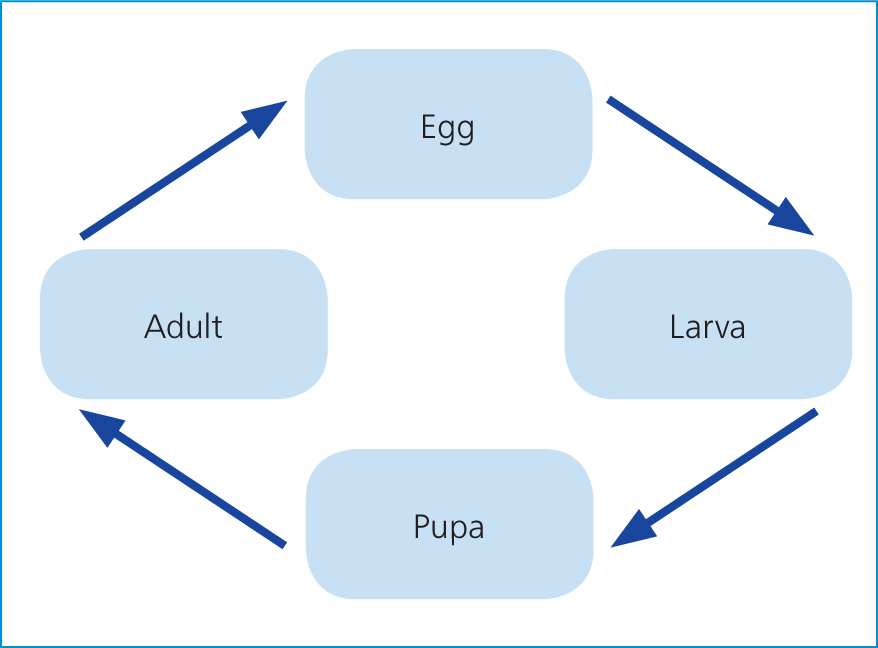
A number of clinical signs may be seen in pets with flea infestation or flea allergy:
- Pruritus — this includes scratching, rubbing, rolling, nibbling and gnawing
- Bacterial skin infection (pyoderma) — the lesions that may be seen associated with this include, papules, pustules, crusts and ‘hot spots’
- Hair loss (alopecia) — the classical area for skin lesions in flea allergic patients is on the caudal dorsum (Figure 2), although in cats alopecia of the ventrum is a common clinical sign (Figure 3)
- Miliary dermatitis — this can be seen in cats, presenting as small crusting lesions that can be felt in the hair coat of an affected patient.
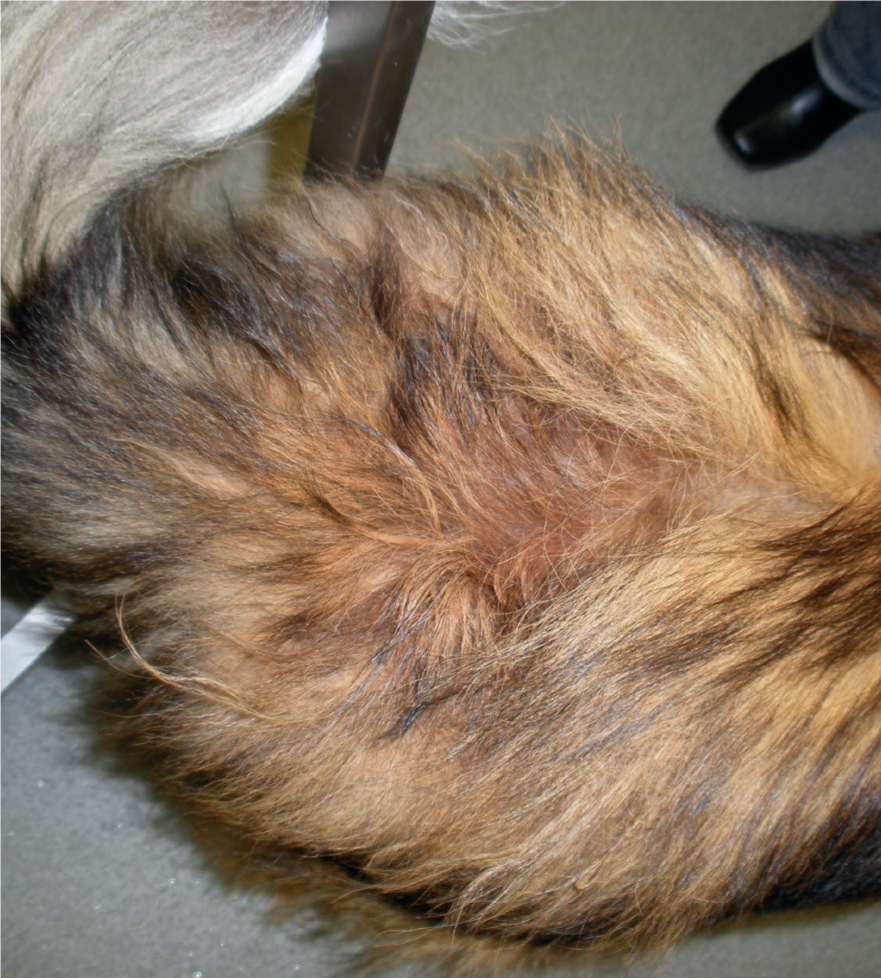
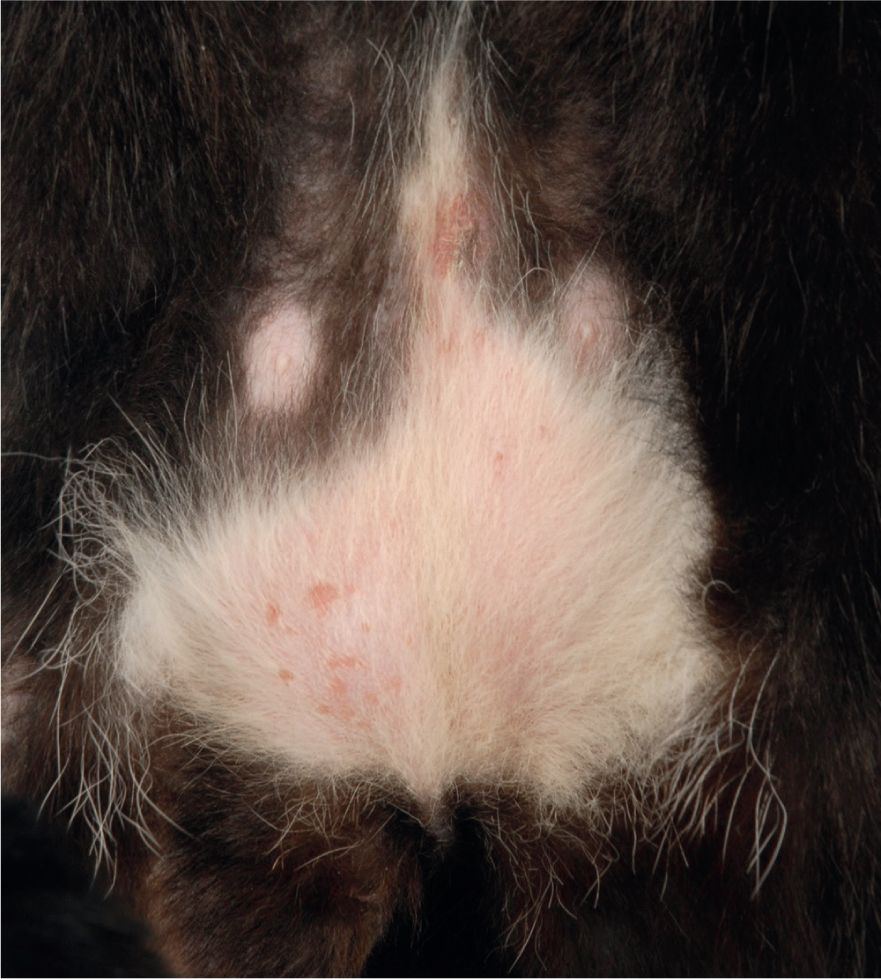
It should be noted that if a patient has flea allergy the clinical signs seen are likely to be much more severe than those noted in a patient with a flea infestation that is not allergic to fleas.
In addition fleas also serve as vectors for other diseases and play an important role in the lifecycle of the tape worm Dipylidium caninum.
Identifying fleas
There are several ways to identify fleas on a pet. The easiest way is to actually identify fleas on the patient. In some cases it is possible to see live fleas in the hair coat; however in a lot of patients with flea allergy it is unusual to see fleas as dogs and cats are efficient groomers. Other tests that can be used to find evidence of fleas on patients are coat brushings (Box 1) (Figure 4) or a wet paper test to look for evidence of flea dirt.
Box 1.How to perform a coat brushingPerforming a coat brushing is a more sensitive method of examining an animal's scale. It enables identification of very small amounts of flea dirt that may not be visible to the naked eye as well as enabling the detection of other parasites.Q: What equipment do I need to perform a coat brushing?
- Piece of paper, if the animal is not able to be placed on the table
- Sellotape or liquid paraffin
- Glass microscope slide
- Cover slip
- Microscope
Q: How do I perform a coat brushing?
- First brush the animal's coat onto a clean table top or onto a piece of paper if the animal is too large to put on the table
- Use a glass slide to collect all the material together
- Lift off the excess hairs. We want to examine the scale and scurf and are less interested in the hairs with this test, although a few hairs are fine
- You then need to mount your sample on a slide. If possible you can mount your sample in liquid paraffin and place a coverslip on top. Or collect it with sellotape from the table top and just stick this to a glass slide. There is no need to stain this sample.
Q: What can I expect to find when examining a coat brushing?Mainly we are looking for flea dirt or surface parasites such as Cheyletiella spp. or lice. This test is especially useful in cats with flea allergy as often it is very difficult to find live fleas on affected animals, because they are so efficient at grooming them off. This test is a good way to convince sceptical owners that flea control is actually required!
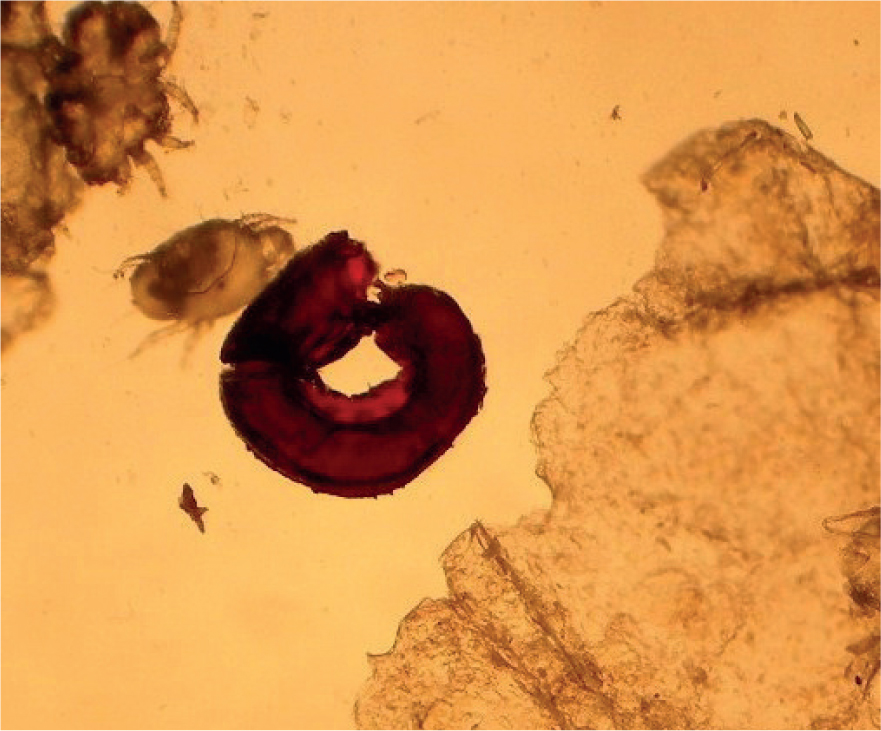
Flea control
In the author's opinion there are three main hurdles to overcome when developing a flea control regimen which are: convincing and educating the owner; flea elimination; and control of the environment.
Convince the owner and educate them
Often the hardest part of dealing with flea allergic dermatitis or instigating a flea control regimen is convincing the owners that fleas are the problem. Sometimes demonstrating fleas by flea combing or evidence of flea faeces in a coat brushing sample can help to motivate the owner to institute a rigorous flea control regimen. However, remember that the biggest cause of adult flea mortality on dogs and cats is grooming and for this reason it is common not to be able to find fleas on flea allergic patients especially cats. Clients need to be educated about the life cycle of the flea so that they understand the importance of environmental control as well as animal treatment. It will also help them realise the importance of treating all in-contact animals.
Eliminate the fleas
There are many effective and easy to use products available for controlling fleas. A rigorous flea control regimen needs to be implemented in households where animals are affected by flea allergic dermatitis. All in-contact animals need to be treated in addition to the affected animal. It is beyond the scope of this article to discuss all the available flea products licensed for use in dogs and cats, but you should become familiar with the products you use in your practice and ensure the owner is using the product correctly.
Environmental control
Environmental control is vital as the adult fleas only represent a small proportion of the life cycle in the pet's environment. Many products are available for this purpose and most combine an adulticide with an insect growth regulator.
Lice
Lice are dorsoventrally flattened, wingless insects. They have three body segments and six legs. There are two main types of lice: biting lice and sucking lice. They are normally visible to the naked eye and are 1–2 mm in length. The types of lice found on dogs and cats are listed below.
Cat
- Felicola subrostrata — biting louse
Dog
- Trichodectes canis — biting louse. This is also a vector for the dog tapeworm D. caninum
- Linognathus setosus — sucking louse.
You can differentiate biting and sucking lice, by looking at their head shape and legs (Table 1).
Table 1. The features of biting and sucking lice
| Biting lice | Sucking lice | |
|---|---|---|
| Head shape | Larger than thorax | Smaller than thorax and elongated |
| Legs | Short stumpy legs | Longer strong powerful legs |
Life cycle
Generally lice have a 14–21 day life cycle and are host specific meaning the life cycle is started and finished on the host. They can only survive for a short time off the host, however when lice are present the environment should be treated.
Clinical signs, diagnosis and treatment
Lice often cause pruritus in dogs and cats. They can be seen with the naked eye; however, coat brushings and tape strips can help confirm the diagnosis. Lice are easily seen under low power magnification using the x4 objective. There are several ectoparasiticides that are effective at treating lice infestations and veterinary nurses can discuss these with pet owners. All in-contact animals and the environment should be treated.
Mites — cheyletiellosis
Cheyletiellosis is typically a very mild, but highly contagious skin condition caused by surface living Cheyletiella spp. mites. They can affect many species but are not thought to be host specific; they will readily transfer between dogs, cats, rabbits and humans. These are large mites with four sets of legs and they are easily recognised by their waisted body and accessory mouth parts that terminate in hooks (Figure 4). They live in the keratin layer of the epidermis and their eggs are loosely attached to hair shafts by fine fibrillar strands. The life cycle of this mite lasts 21 days and is completed on the host.
Clinical signs, diagnosis and treatment
Clinical signs include lesions which are usually seen as excessive scaling often on the trunk and dorsum, often associated with pruritus. The excessive scaling is often referred to as ‘walking dandruff’. Some animals can be asymptomatic carriers and may act as a source of infestation for other animals.
Diagnosis can be made by observing the walking dandruff with a hand lens or by performing a coat brushing. There are currently no licensed treatments for dealing with this ectoparasite in the UK, although Fipronil (Frontline spray®, Boehringer Ingelheim) may aid in the control of cheyletiellosis. An imidocloprid 10%/moxidectin 2.5% spot on (Advocate®, Bayer) (White et al, 2001) and selamectin spot on (Stronghold®, Zoetis)(Chailleux and Paradis, 2002) are both reported to be safe and efficacious when treating dogs with cheyletiellosis. It is important that all in-contact animals are treated and bedding and grooming equipment should be decontaminated.
Mites — demodicosis
Demodex canis is an obligate parasite of dog skin which lives in hair follicles and is the most commonly isolated Demodex spp. mite in dogs. Most normal dogs will carry a small number of the mites without displaying any clinical signs, but under certain conditions the numbers of mites can increase and cause demodicosis. A long bodied mite Demodex injai (Figure 5) has been described which resides in the sebaceous glands of the skin. These mites spend their entire life cycle on the dog's skin.
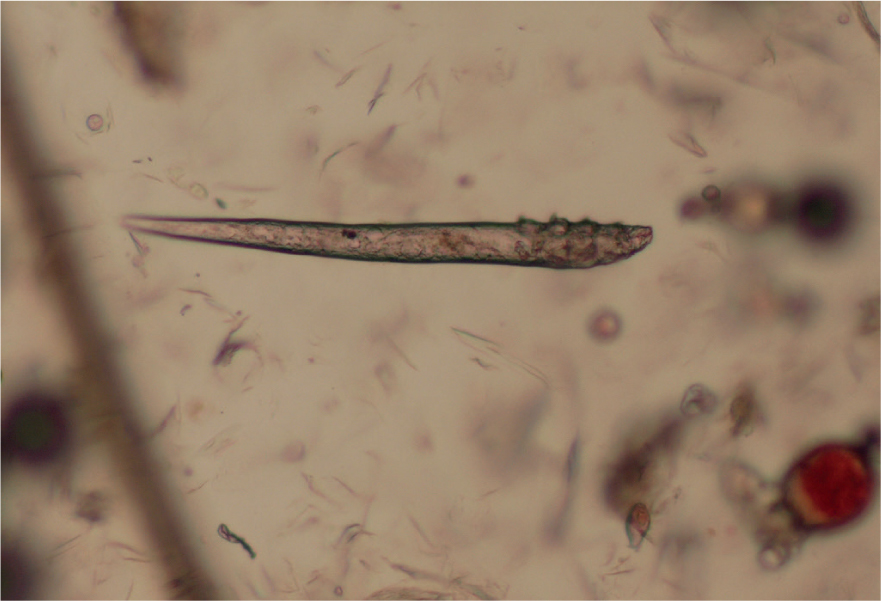
Feline demodicosis can be caused by Demodex cati or Demodex gatoi, and is considered a rare disease in the UK, but can be an important cause of pruritus in cats.
Life cycle
The mites are transmitted from the bitch to her nursing puppies within the first few days of life. The mites feed on skin cells, sebum and epidermal debris. The life cycle of the mite is shown in Figure 6 and takes approximately 3 weeks to complete.
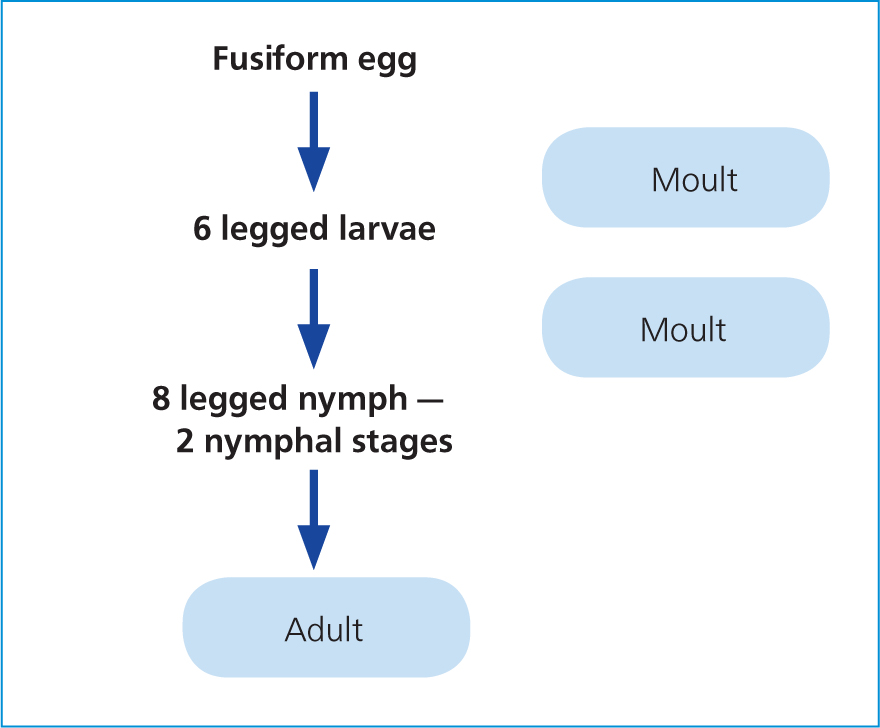
Demodicosis in dogs
A hereditary predisposition is likely and some breeds are considered at increased risk for developing demodicosis including the English Bulldog, Shar Pei, Staffordshire Bull Terrier, West Highland white terrier and German Shepherd dog (Scott et al, 2001).
Two forms of the disease are recognised: a localised and a generalised form.
Localised demodicosis
Localised demodicosis usually occurs in young dogs and it frequently self resolves (Figure 6). The clinical signs seen usually consist of one or more small erythematous or hyperpigmented (dark), alopecic and scaly lesions. Generally a dog is considered to have the localised form if it has less than 6–8 localised lesions that do not involve the feet. These cases may spontaneously resolve without treatment in otherwise healthy dogs, or they can progress to the generalised form.
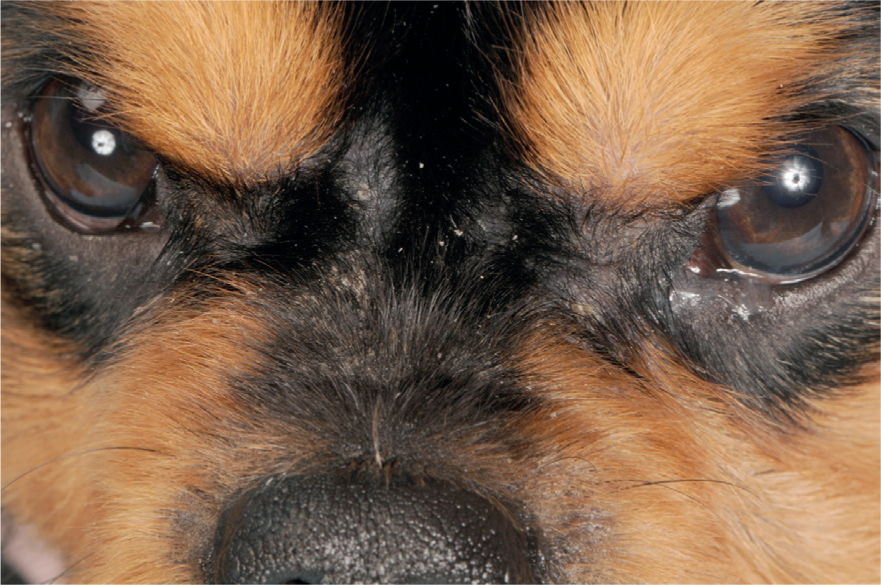
Generalised demodicosis
Generalised demodicosis is a severe form of the disease. It can be further classified into juvenile onset or adult onset. Juvenile onset disease usually begins in dogs less than 18 months of age. Adult onset disease is often seen in conjunction with an underlying disease such as a hormonal problem like hyperadrenocorticism (Cushing's disease) or hypothyroidism. It can also be seen in patients on chemotherapy as their immune system is suppressed. All cases of generalised demodicosis require treatment.
Clinical signs
Clinical signs that can be seen are variable and include the following (Figures 7 and 8):
- Alopecia
- Scaling
- Follicular casts and comedones (black heads)
- Erythema
- Variable pruritus — generally only pruritic when there is secondary infection
- Secondary bacterial infection
- Enlarged lymph nodes
- Pain and fever may also be present depending on the severity of the disease
- Most commonly affects: feet, legs and trunk
- D. injai — greasy skin and hair coat on the dorsum is the most common clinical sign. This has been reported most commonly in Fox Terriers, but can also be seen in other breeds.
- In adult onset disease there may be signs associated with underlying diseases such as polydipsia and polyuria.
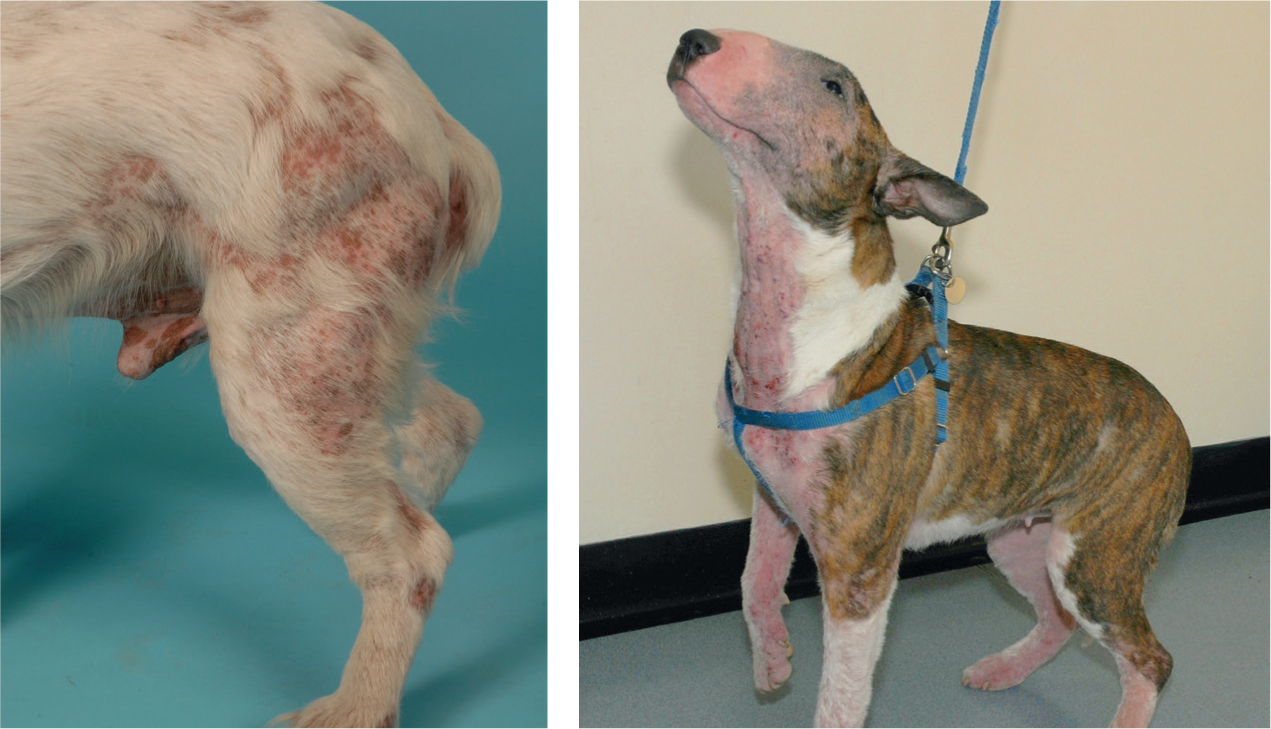
Diagnosis
Skin scrapings or hair pluck samples are required for diagnosis. Hair plucks are especially useful in areas that are difficult to skin scrape such as the feet. The samples are then mounted in liquid paraffin and a coverslip is placed on top of the sample. The slide is then examined using a low power objective (x4 or x10) under the microscope. In affected animals most life stages should be present in the samples (Figure 9).
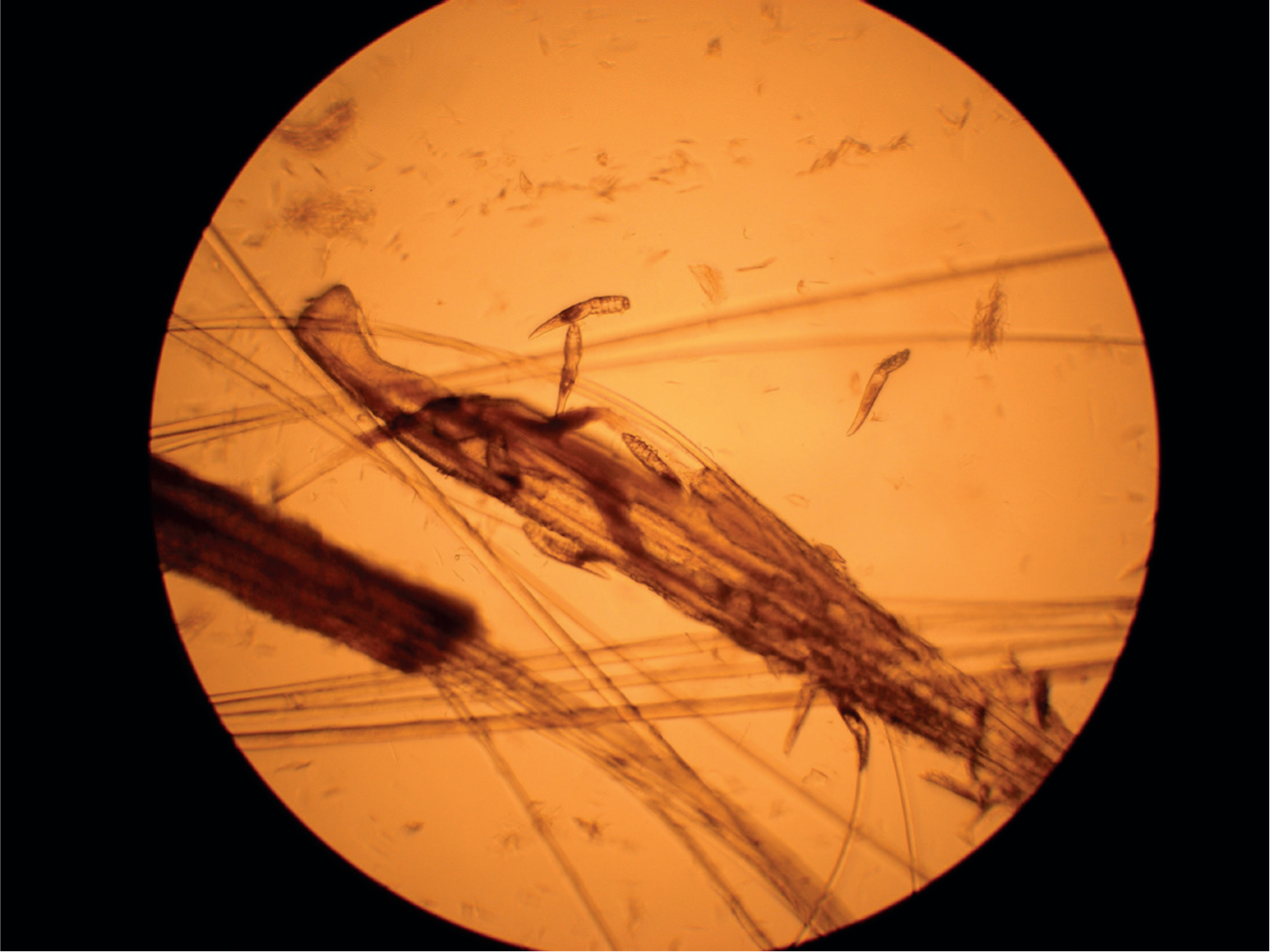
Treatment
Aims of treatment
- Treat any secondary infection, which is commonly present in these cases
- Address any underlying disease processes
- Miticidal treatment to kill the parasite.
What treatments are available?
The isoxazolines are a relatively new group of ectoparasitic drugs and includes fluralaner (Bravecto®, MSD Animal Health), sarolaner (Simparica®, Zoetis), afoxolaner (Nexgard®, Nexgard Spectra®, Boehringer Ingelheim) and lotilaner (Credelio®, Elanco). To date all except Credelio® are licensed treatments for demodicosis and have been shown to be effective (Becskei et al, 2018; Duangkaew et al, 2018). These should be the first line treatment for cases of demodicosis. Other treatments that have been used in the past include amitraz, ivermectin, and moxidectin.
Treatment should be monitored by regular skin scrapes and hair pluck samples at least every 4 weeks. Therapy should be continued until at least two sets of negative skin scrapes or hair plucks are obtained 4 weeks apart.
Sarcoptic mange
This is a highly contagious skin disease caused by the mite Sarcoptes scabeii, which is a burrowing mite. It is common in the dog and extremely rare in the cat. Dogs can be infected via direct contact with an infested dog or fox, but transmission can also occur indirectly via contact with fomites.
Clinical signs
In dogs clinical signs include: an intensely pruritic, papular, crusting dermatitis which commonly affects the pinnae, elbows and hocks, but can also become generalised.
Diagnosis
Skin scrapes are the only in-house test that will help identify this mite, but it is challenging as there is only a small chance of finding the mite in multiple skin scraping samples. There is also a blood test available which measures Sarcoptes spp. IgG and this is a reliable test providing the patient has had clinical signs for longer than 3 weeks (Bornstein and Zakrisson, 1993; Curtis, 2001; Lower et al, 2001). Due to the challenges in diagnosing sarcoptic mange sometimes trial treatment is used as a diagnostic test (Curtis, 2004).
Treatment
There are several licensed treatments available in the UK. — namely selamectin spot–on (Stronghold®, Zoetis), imidacloprid 10%/moxidectin 2.5% spot-on (Advocate®, Bayer; Prinovox®, Virbac UK), sarolaner (Simparica®, Zoetis), afoxolaner (Nexgard®, Nexgard Spectra®, Boehringer Ingelheim), and fluralaner (Bravecto®, MSD Animal Health)
It is important that all in-contact dogs are treated concurrently and the environment should also be treated with an appropriate acaricidal spray. In many cases it is also necessary to give the patient some treatment to alleviate the itching, while the miticidal therapy takes effect.
Conclusion
Ectoparasites are a common cause of pruritus in dogs and cats. Most can be easily diagnosed in practice using simple in-house testing and a microscope. There are a variety of treatments available to effectively treat these conditions, but owner compliance and consideration of the pet's lifestyle is important when advising on treatment regimens.
KEY POINTS
- Parasites are a common cause of pruritus in dogs and cats.
- Parasites can be easily identified by examining skin samples using low power microscopy.
- There are a variety of licensed treatments available to treat the ectoparasitic conditions described.
- Treatment for parasitic conditions needs to be tailored to the patient and the client's needs.


